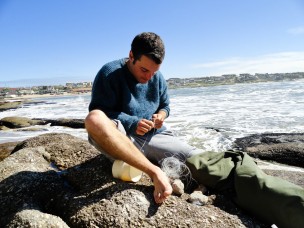
“How can feeding nine billion people by 2050 and tackling the current mass extinction of biodiversity on our planet be reconciled?” wrote Damian Carrington, on the Guardian’s Environment Blog.
I’m writing from Ecuador, where farmers, conservationists, agronomists, government officials, and indigenous groups struggle daily to balance agricultural production and wildlife conservation. I realized I couldn’t be in a better place to get an in-depth look on this issue, so I spoke with Rosa Espinosa, an agronomy professor; Alfredo Duenas, the project director for a foundation called Conservation and Development; and William Pacheco, who works for a multinational agrochemical company.
Traditionally, journalists and academics present the debate in a bipolar fashion.
They have theorized that rising demand for agricultural land is causing tension between wildlife conservation and food security. There are two ways to address this issue: “land sharing”—farming less efficiently, but using a method that is friendly to wildlife—or “land sparing,” which means farming intensively while protecting biodiversity-rich land.
“Land sharing” is less efficient because it requires more land. Therefore, as the logic goes, conservationists are forced to choose between two evils: destroying more wildlife habitats or employing intensive industrial farming, which spreads pollutants downstream into places of high biodiversity.
During the process of conducting interviews for this column, I was surprised to encounter ideas and information that reframed the biodiversity/food security question. The experts with whom I talked highlighted the importance of understanding the technicalities of agricultural production and the root causes of deforestation and hunger.
I started each conversation with a simple question: “How strong is the connection between demand for agricultural products and deforestation in Ecuador?”
Duenas and Espinosa agreed that serious government commitment to land protection is the most direct way to ensure that land is protected.
According to Duenas, agriculture and related industries have had had a limited impact on deforestation because “the demand for land in the Amazon can be covered by land that has already been cleared but is not yet cultivated.”
Espinosa added that “forests often come down simply because they are an easy source for wood, which is unrelated to food demand.”
These responses imply that “sparing” land by increasing agricultural efficiency does not guarantee that land will actually be spared. Nevertheless, increasing agricultural efficiency reduces the industry’s need for land, so it is worth considering what it actually means to “intensify” agriculture.
I then asked: “Assume we need to increase agricultural efficiency in order to protect forests and meet rising demand. In Ecuador, where is there capacity for increased efficiency, how great is it, and what would the environmental and social costs be of this increase?”
“The main cause of inefficiency is the lack of access to credit and technology among small farmers,” Duenos said.
When Duenos and Espinosa spoke of technology, they meant precise and consistent irrigation, and seed varieties that are resistant to pests, abiotic factors (droughts, floods, etc.), and storage facilities (because about 35 percent of produce in the developing world goes bad before it reaches markets).
Most, if not all, of these technological investments have “little environmental impact” according to Espinosa.
Pacheco believes, however, that when it comes to fertilizer and pesticides, some environmental consequences are inevitable.
“Artificial ones don’t protect the soil. But if you use only organic ones, you have to cultivate more land to grow these inputs,” he said.
Neither Espinosa nor Duenas thought that fertilizer and pesticides are the main limiting factors when it comes agricultural efficiency. In terms of credit, it is difficult for small farmers to invest in technologies because in Ecuador they usually don’t own the land they work on. Additionally, interest on small loans is almost double for larger loans.
Pacheco said that lack of credit among small farmers forces them to only be able to “take reactionary steps against plagues, but not preventative ones.”
Espinosa argued that the capacity for increased efficiency among small farmers in Ecuador is “gigantic.”
“[T]he land, the knowledge and the technology is already there. What this project requires is effort and commitment,” Duenas said.
“Intensifying” agriculture, according to these experts, doesn’t have to mean confining wildlife to reserves.
Towards the end of the discussions, I changed the subject to food security.
“Hypothetically, if the world were to commit to protecting all of our forest, and to cultivating only land that was already cleared, could we feed our rising population?” I asked. “If so, what sacrifices would have to be made?”
All three experts agreed we could avoid both. But there were four fairly convincing reasons why this win-win outcome is unlikely. For one, people like meat. And as incomes rise, so does demand for meat.
“Production of meat is incredibly inefficient in terms of land-to-food calorie ratio, so producing more meat essentially means producing less food on more land,” Espinosa said.
Secondly, an increasing amount of agricultural land is being used for non-food products, such as bio-fuels. Espinosa argued that, as energy demand rises and we pass peak oil, “the diversion of food-to-bio-fuel will become even more widespread.”
Thirdly, enough food is currently produced to feed the world. Solving hunger without deforestation wouldn’t be so complicated if the word “distribution” wasn’t taboo in political dialogue.
Fourth, financial speculation on food, which has practically doubled in the past five years, helps raise food prices to levels that are increasingly out of reach for people in the developing world. According to Espinosa, curbing speculation, reducing meat and biofuel consumption, and making sure that everyone has enough food “has to be at least on the table” when we’re talking about food security and deforestation.
In talking with people who are deeply involved in agriculture and conservation, I began to see that there’s one more important factor that stands in the way of simultaneously protecting forests and achieving food security: correctly framing the conversation.
Our collective thinking on these issues will continue to be limited if we believe that increasing total agricultural production is the only road to food security, that the world faces a simple choice between wildlife-friendly farming that causes deforestation and unsustainable farming that protects forests.
As these Ecuadorian experts argued, the complicated reality is that we have to be open to confronting deforestation and hunger from multiple angles and with multiple tools.



Leave a Reply